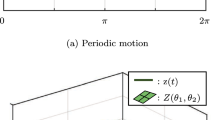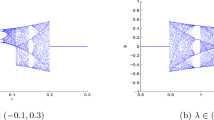Abstract
The multi-revolution elliptic halo (ME-Halo) orbit is a kind of strictly periodic orbit existing in the elliptic restricted three-body problem (ERTBP) model. Its remarkable features include that it survives the eccentricity perturbation of the primaries, it has a long period commeasurable with the primary period and that its stability property varies greatly as the eccentricity. The authors utilized continuation methods together with the multi-segment optimization method to generate two groups of ME-Halo orbits, and then systematically investigated their stability evolution with respect to the eccentricity and the mass ratio of the primaries. These parameters show complicate impacts on the stability. Some ME-Halo orbits can possess more than one pairs of real eigenvalue, some have negative real eigenvalues or complex eigenvalues out of the unit circle. For certain parameters, continuation failures are observed to be accompanied by a series of eigenvalue collision and bifurcations. The results in this paper can help to understand the nonautonomous dynamic of the ERTBP and can further aid in understanding the dynamical environment for real-world applications and, thus, contribute to the trajectory development process.




















Similar content being viewed by others
References
Antoniadou, K.I., Voyatzis, G.: 2/1 Resonant periodic orbits in three dimensional planetary systems. Celest. Mech. Dyn. Astron. 115(2), 161–184 (2013). doi:10.1007/s10569-012-9457-4
Barden, B., Howell, K.C., Lo, M.: Application of dynamical systems theory to trajectory design for a libration point mission. 268–281 (1996). doi:10.2514/6.1996-3602
Belbruno, E.A., Gidea, M., Topputo, F.: Geometry of weak stability boundaries. Qual. Theory Dyn. Syst. (2012). doi:10.1007/s12346-012-0069-x
Bittanti, S., Colaneri, P.: Periodic Systems, vol. 36. Communications and Control Engineering. Springer, London (2009)
Broucke, R.A.: Stability of periodic orbits in the elliptic, restricted three-body problem. AIAA J. 7(6), 1003–1009 (1969). doi:10.2514/3.5267
Campagnola, S.: New Techniques in Astrodynamics for Moon Systems Exploration. Ph.D. Dissertation, University of Southern California (2010)
Campagnola, S., Lo, M.W., Newton, P.: Subregions of motion and elliptic halo orbits in the elliptic restricted three-body problem. In: 18th AAS/AIAA Spaceflight Mechanics Meeting, Galveston (2008)
Farquhar, R.W., Kamel, A.A.: Quasi-periodic orbits about the translunar libration point. Celest. Mech. 7(4), 458–473 (1973). doi:10.1007/BF01227511
Gomez, G., Koon, W.S., Lo, M.W., Marsden, J.E., Masdemont, J.J., Ross, S.D.: Connecting orbits and invariant manifolds in the spatial restricted three-body problem. Nonlinearity 17(5), 1571–1606 (2004). doi:10.1088/0951-7715/17/5/002
Gurfil, P., Kasdin, N.J.: Niching genetic algorithms-based characterization of geocentric orbits in the 3D elliptic restricted three-body problem. Comput. Methods Appl. Mech. Eng. 191(49–50), 5683–5706 (2002). doi:10.1016/S0045-7825(02)00481-4
Gurfil, P., Meltzer, D.: Semi-analytical method for calculating the elliptic restricted three-body problem monodromy matrix. J. Guid. Control Dyn. 30(1), 266–271 (2007). doi:10.2514/1.22871
Heppenheimer, T.A.: Out-of-plane motion about libration points: nonlinearity and eccentricity effects. Celest. Mech. 7(2), 177–194 (1973). doi:10.1007/BF01229946
Hiday, L.A., Howell, K.C.: Transfers between libration-point orbits in the elliptic restricted problem. Celest. Mech. Dyn. Astron. 58(4), 317–337 (1994). doi:10.1007/BF00692008
Hou, X.Y., Liu, L.: On motions around the collinear libration points in the elliptic restricted three-body problem. Mon. Not. R. Astron. Soc. 415(4), 3552–3560 (2011). doi:10.1111/j.1365-2966.2011.18970.x
Howell, K.C., Pernicka, H.J.: Numerical determination of Lissajous trajectories in the restricted three-body problem. Celest. Mech. 41(1–4), 107–124 (1987). doi:10.1007/BF01238756
Hyeraci, N., Topputo, F.: Method to design ballistic capture in the elliptic restricted three-body problem. J. Guid. Control. Dyn. 33(6), 1814–1823 (2010). doi:10.2514/1.49263
Hyeraci, N., Topputo, F.: The role of true anomaly in ballistic capture. Celest. Mech. Dyn. Astron. 116(2), 175–193 (2013). doi:10.1007/s10569-013-9481-z
Ichtiaroglou, S.: Elliptic Hill’s problem—the continuation of periodic orbits. Astron. Astrophys. 92, 139–141 (1980)
Ichtiaroglou, S., Michalodimitrakis, M.: Three-body problem—the existence of families of three-dimensional periodic orbits which bifurcate from planar periodic orbits. Astron. Astrophys. 81, 30–32 (1980)
Koon, W.S., Lo, M.W., Marsden, J.E., Ross, S.D.: Shoot the moon. In: Spaceflight Mechanics 2000. Advances in Astronautical Sciences. No. 105. American Astronautical Society, pp. 1017–1030. San Diego (2000)
Koon, W.S., Lo, M.W., Marsden, J.E., Ross, S.D.: Dynamical Systems, The Three-Body Problem and Space Mission Design. Marsden Books (2011)
Lei, H., Xu, B., Hou, X., Sun, Y.: High-order solutions of invariant manifolds associated with libration point orbits in the elliptic restricted three-body system. Celest. Mech. Dyn. Astron. 117(4), 349–384 (2013). doi:10.1007/s10569-013-9515-6
Mahajan, B.: Libration point orbits near small bodies in the elliptic restricted three-body problem. Masters Theses. Paper 7200 (2013). http://scholarsmine.mst.edu/masters_theses/7200
Mahajan, B., Pernicka, H.J.: Halo orbits near small bodies in the elliptic restricted problem. 1–9 (2012). doi:10.2514/6.2012-4876
Martin, C., Conway, B.A., Ibán̈ez, P.: Optimal Low-Thrust Trajectories to the Interior Earth-Moon Lagrange Point. In: Space Manifold Dynamics, pp. 161–184. New York, NY: Springer (2010)
Meyer, K.R., Hall, G.R., Offin, D.: Introduction to Hamiltonian dynamical systems and the N-body problem. In: Antman S.S., Marsden J.E., Sirovich L. (eds.) Applied Mathematical Sciences, vol. 90, 2nd edn. Springer, New York (2009)
Moulton, F.R.: Periodic Orbits. Carnegie Institution of Washington, Washington (1920)
Parker, J.S., Anderson, R.L.: Low-energy lunar trajectory design, 1st edn. In: JPL Deep-Space Communications and Navigation Series. Wiley (2014)
Pernicka, H.J.: The numerical determination of nominal libration point trajectories and development of a station-keeping strategy. Purdue University (1990)
Qi, Y., Xu, S.: Lunar capture in the planar restricted three-body problem. Celest. Mech. Dyn. Astron. 120(4), 401–422 (2014). doi:10.1007/s10569-014-9582-3
Qi, Y., Xu, S., Qi, R.: Gravitational lunar capture based on bicircular model in restricted four body problem. Celest. Mech. Dyn. Astron. 120(1), 1–17 (2014a). doi:10.1007/s10569-014-9554-7
Qi, Y., Xu, S., Qi, R.: Study of the gravitational capture at mercury in the elliptic restricted three-body problem. In: Proceedings 24th International Symposium on Space Flight Dynamics—24th ISSFD, 2014.05.06 (2014b)
Richardson, D.L.: Analytic construction of periodic orbits about the collinear points. Celest. Mech. 22(3), 241–253 (1980). doi:10.1007/BF01229511
Russell, R.P.: Survey of spacecraft trajectory design in strongly perturbed environments. J. Guid. Control Dyn. 35(3), 705–720 (2012). doi:10.2514/1.56813
Sarris, E.: Families of symmetric-periodic orbits in the elliptic three-dimensional restricted three-body problem. Astrophys. Space Sci. 162(1), 107–122 (1989). doi:10.1007/BF00653348
Szebehely, V.G.: Theory of Orbits—The Restricted Problem of Three Bodies. Academic Press, New York (1967)
Tarragó, P.I.: Study and assessment of low-energy Earth–Moon transfer trajectories. Université de Liège (2007)
Wiggins, S.: Introduction to Applied Nonlinear Dynamical Systems and Chaos, 2nd edn. Springer, New York (2003). http://www.springer.com/us/book/9780387001777#aboutBook
Acknowledgments
The research presented in this paper was supported by the State Key Program of National Natural Science of China (Grant No. 11432001). The authors would like to thank all editors and the anonymous reviewers for all their hard work. The reviewers not only gave critical comments on the paper which greatly improves the quality of this paper, but also generously shared their knowledge, insights and suggestions with us, which are very helpful for our future research.
Author information
Authors and Affiliations
Corresponding author
Rights and permissions
About this article
Cite this article
Peng, H., Xu, S. Stability of two groups of multi-revolution elliptic halo orbits in the elliptic restricted three-body problem. Celest Mech Dyn Astr 123, 279–303 (2015). https://doi.org/10.1007/s10569-015-9635-2
Received:
Revised:
Accepted:
Published:
Issue Date:
DOI: https://doi.org/10.1007/s10569-015-9635-2




